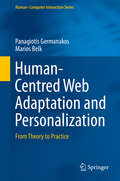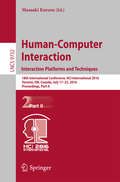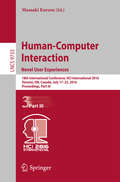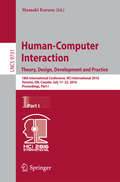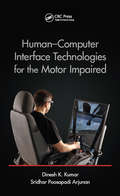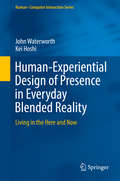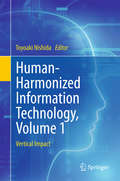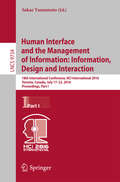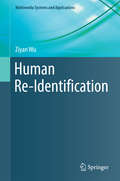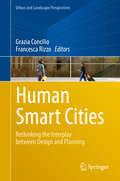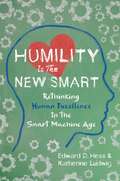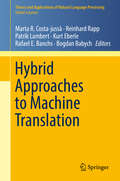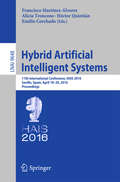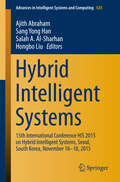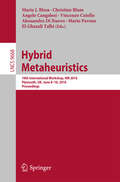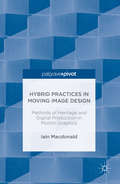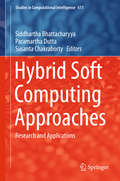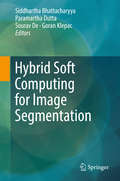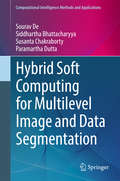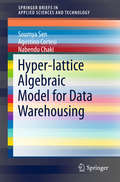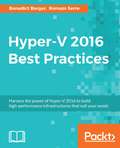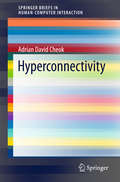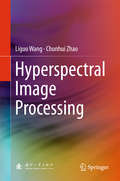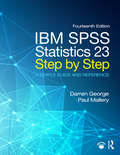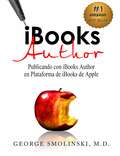- Table View
- List View
Human-Centred Web Adaptation and Personalization
by Panagiotis Germanakos Marios BelkThis book focuses on theimportance of adaptation and personalization in today's society and theupgraded role computational systems and the Internet play in our day-to-dayactivities. In this era of wireless communication, pervasive computing and the Internet of Things, it is becoming increasingly critical to ensure humans remain central in the developmental process of new technologies to guarantee their continued usefulness and a positive end-user experience. Organized into three clear parts - theory, principles and practice, a holistic approach to designing and developing adaptive interactive systems and services has been adopted. With an emphasis on distinct human factors, both basic and applied research topics are explored, extending from human-centred user models, driven by user's individual differences in cognitive processing and emotions, to the creation of smart interfaces that can handle the ever increasing volume and complexity of information to the benefit of the end-user. Human-Centred Web Adaptation and Personalization - From Theory to Practice is meticulously crafted to serve researchers, practitioners, and students who wish to have an end-to-end understanding of how to convert pure research and scientific results into viable user interfaces, system components and applications. It will serve to bridge the knowledge gap that still remains by suggesting interaction design and implementation guidelines for areas like E-Commerce, E-Learning and Usable Security.
Human-Computer Interaction. Interaction Platforms and Techniques
by Masaaki KurosuThe 3-volume set LNCS 9731, 9732, and 9733 constitutes the refereed proceedings of the 18th International Conference on Human-Computer Interaction, HCII 2016, held in Toronto, ON, Canada, in July 2016. The total of 1287 papers presented at the HCII 2016 conferences was carefully reviewed and selected from 4354 submissions. The papers thoroughly cover the entire field of Human-Computer Interaction, addressing major advances in knowledge and effective use of computers in a variety of application areas. The volumes constituting the full 27-volume set of the conference proceedings.
Human-Computer Interaction. Novel User Experiences
by Masaaki KurosuThe 3-volume set LNCS 9731, 9732, and 9733 constitutes the refereed proceedings of the 18th International Conference on Human-Computer Interaction, HCII 2016, held in Toronto, ON, Canada, in July 2016. The total of 1287 papers presented at the HCII 2016 conferences was carefully reviewed and selected from 4354 submissions. The papers thoroughly cover the entire field of Human-Computer Interaction, addressing major advances in knowledge and effective use of computers in a variety of application areas. The volumes constituting the full 27-volume set of the conference proceedings.
Human-Computer Interaction. Theory, Design, Development and Practice
by Masaaki KurosuThe 3-volume set LNCS 9731, 9732, and 9733 constitutes the refereed proceedings of the 18th International Conference on Human-Computer Interaction, HCII 2016, held in Toronto, ON, Canada, in July 2016. The total of 1287 papers presented at the HCII 2016 conferences was carefully reviewed and selected from 4354 submissions. The papers thoroughly cover the entire field of Human-Computer Interaction, addressing major advances in knowledge and effective use of computers in a variety of application areas. The volumes constituting the full 27-volume set of the conference proceedings are listed on pages VII and VIII.
Human-Computer Interface Technologies for the Motor Impaired (Rehabilitation Science In Practice Ser.)
by Dinesh K. Kumar Sridhar Poosapadi ArjunanHuman Computer Interface Technologies for the Motor Impaired examines both the technical and social aspects of human computer interface (HCI). Written by world-class academic experts committed to improving HCI technologies for people with disabilities, this all-inclusive book explores the latest research, and offers insight into the current limitat
Human-Experiential Design of Presence in Everyday Blended Reality
by John Waterworth Kei HoshiThis book explores how our lives and social interactions have become split between two intertwined, but not integrated, realities: the physical and the digital. Our sense of presence in the here and now has become fragmented, and yet earlier design approaches reinforced the problem, rather than leading to improvements. The authors address these issues by laying out a new human computer interaction (HCI) design approach - human-experiential design - rooted in a return to first principles of how people understand the world, both consciously and unconsciously. The application of this approach to the design of blended reality spaces is described in detail. Examples and scenarios of designing them to overcome the problems inherent in a variety of mixed reality settings are provided. Human-Experiential Design of Presence in Everyday Blended Reality will appeal to undergraduate and graduate students and researchers in interaction design, psychology, HCI and computer application studies, as well as practicing interaction designers and computer professionals. It will also be of interest to communication, media and urban design students, and to all readers with an interest in the technology-mediated future.
Human-Harmonized Information Technology, Volume 1
by Toyoaki NishidaGoing from the philosophy and concepts to the implementation and user study, this book presents an excellent overview of Japan's contemporary technical challenges in the field of human-computer interaction. The next information era will be one in which information is used to cultivate human and social potential. Driven by this vision, the outcomes provided in this work were accomplished as challenges to establish basic technologies for achieving harmony between human beings and the information environment by integrating element technologies including real-space communication, human interfaces, and media processing. Ranging from the neuro-cognitive level to the field trial, the research activities integrated novel perceptual technologies that even exceed human ability to sense, capture, and affect the real world. This book grew out of one of the CREST research areas funded by the Japan Science and Technology Agency. The theme of the project is "the creation of human-harmonized information technology for convivial society", where 17 research teams aimed at a common goal. The project promotes a trans-disciplinary approach featuring (1) recognition and comprehension of human behaviors and real-space contexts by utilizing sensor networks and ubiquitous computing, (2) technologies for facilitating man-machine communication by utilizing robots and ubiquitous networks, and (3) content technologies for analyzing, mining, integrating, and structuring multimedia data including those in text, voice, music, and images. This is the first of two volumes, which is contributed by nine team leaders. Besides describing the technical challenges, each contribution lays much weight on discussing the philosophy, concepts, and the implications underlying the project. This work will provide researchers and practitioners in the related areas with an excellent opportunity to find interesting new developments and to think about the relationship between human and information technology.
Human Interface and the Management of Information: 18th International Conference, HCI International 2016 Toronto, Canada, July 17-22, 2016, Proceedings, Part I (Lecture Notes in Computer Science #9734)
by Sakae YamamotoThe two-volume set LNCS 9734 and 9735 constitutes the refereed proceedings of the Human Interface and the Management of Information thematic track, held as part of the 18th International Conference on Human-Computer Interaction, HCII 2016, held in Toronto, Canada, in July 2016. HCII 2016 received a total of 4354 submissions of which 1287 papers were accepted for publication after a careful reviewing process. These papers address the latest research and development efforts and highlight the human aspects of design and use of computing systems. The papers accepted for presentation thoroughly cover the entire field of human-computer interaction, addressing major advances in knowledge and effective use of computers in a variety of application areas This volume contains papers addressing the following major topics: information presentation; big data visualization; information analytics; discovery and exploration; interaction design, human-centered design; haptic, tactile and multimodal interaction.
Human Re-Identification
by Ziyan WuThis book covers aspects of human re-identification problems related to computer vision and machine learning. Working from a practical perspective, it introduces novel algorithms and designs for human re-identification that bridge the gap between research and reality. The primary focus is on building a robust, reliable, distributed and scalable smart surveillance system that can be deployed in real-world scenarios. This book also includes detailed discussions on pedestrian candidates detection, discriminative feature extraction and selection, dimension reduction, distance/metric learning, and decision/ranking enhancement. This book is intended for professionals and researchers working in computer vision and machine learning. Advanced-level students of computer science will also find the content valuable.
Human Smart Cities
by Francesca Rizzo Grazia ConcilioWithin the most recent discussion on smart cities and the way this vision is affecting urban changes and dynamics, this book explores the interplay between planning and design both at the level of the design and planning domains' theories and practices. Urban transformation is widely recognized as a complex phenomenon, rich in uncertainty. It is the unpredictable consequence of complex interplay between urban forces (both top-down or bottom-up), urban resources (spatial, social, economic and infrastructural as well as political or cognitive) and transformation opportunities (endogenous or exogenous). The recent attention to Urban Living Lab and Smart City initiatives is disclosing a promising bridge between the micro-scale environments, with the dynamics of such forces and resources, and the urban governance mechanisms. This bridge is represented by those urban collaborative environments, where processes of smart service co-design take place through dialogic interaction with and among citizens within a situated and cultural-specific frame.
Humility Is the New Smart: Rethinking Human Excellence in the Smart Machine Age
by Edward D. Hess Katherine LudwigHumility Is the New Smart Your job is at risk—if not now, then soon. We are on the leading edge of a Smart Machine Age led by artificial intelligence that will be as transformative for us as the Industrial Revolution was for our ancestors. Smart machines will take over millions of jobs in manufacturing, office work, the service sector, the professions, you name it. Not only can they know more data and analyze it faster than any mere human, say Edward Hess and Katherine Ludwig, but smart machines are free of the emotional, psychological, and cultural baggage that so often mars human thinking. So we can't beat 'em and we can't join 'em. To stay relevant, we have to play a different game. Hess and Ludwig offer us that game plan. We need to excel at critical, creative, and innovative thinking and at genuinely engaging with others—things machines can't do well. The key is to change our definition of what it means to be smart. Hess and Ludwig call it being NewSmart. In this extraordinarily timely book, they offer detailed guidance for developing NewSmart attitudes and four critical behaviors that will help us adapt to the new reality. The crucial mindset underlying NewSmart is humility—not self-effacement but an accurate self-appraisal: acknowledging you can't have all the answers, remaining open to new ideas, and committing yourself to lifelong learning. Drawing on extensive multidisciplinary research, Hess and Ludwig emphasize that the key to success in this new era is not to be more like the machines but to excel at the best of what makes us human.
Hybrid Approaches to Machine Translation
by Marta R. R. Costa-jussà Reinhard Rapp Patrik Lambert Kurt Eberle Rafael E. E. Banchs Bogdan BabychThis volume provides an overview of thefield of Hybrid Machine Translation (MT) and presents some of the latestresearch conducted by linguists and practitioners from differentmultidisciplinary areas. Nowadays, most important developments in MT are achievedby combining data-driven and rule-based techniques. These combinationstypically involve hybridization of different traditional paradigms, such as theintroduction of linguistic knowledge into statistical approaches to MT, theincorporation of data-driven components into rule-based approaches, orstatistical and rule-based pre- and post-processing for both types of MTarchitectures. The book is of interest primarily to MTspecialists, but also - in the wider fields of Computational Linguistics,Machine Learning and Data Mining - to translators and managers of translationcompanies and departments who are interested in recent developments concerningautomated translation tools.
Hybrid Artificial Intelligent Systems
by Francisco Martínez-Álvarez Alicia Troncoso Héctor Quintián Emilio CorchadoThisvolume constitutes the refereed proceedings of the 11th International Conferenceon Hybrid Artificial Intelligent Systems, HAIS 2016, held in Seville, Spain, inApril 2016. The 63full papers published in this volume were carefully reviewed and selected from150 submissions. They are organized in topical sections on data mining andknowledge discovery; time series; bio-inspired models and evolutionary computation;learning algorithms; video and image; classification and cluster analysis; applications;bioinformatics; and hybrid intelligent systems for data mining and applications.
Hybrid Intelligent Systems
by Hongbo Liu Salah A. Al-Sharhan Sang Yong Han Ajith AbrahamThis bookis devoted to the hybridization of intelligent systems which is a promisingresearch field of modern computational intelligence concerned with thedevelopment of the next generation of intelligent systems. This Volume containsthe papers presented in the Fifteenth International conference on HybridIntelligent Systems (HIS 2015) held in Seoul, South Korea during November 16-18, 2015. The 26 papers presented in this Volume were carefully reviewed andselected from 90 paper submissions. The Volume will be a valuable referenceto researchers, students and practitioners in the computational intelligencefield.
Hybrid Metaheuristics
by Maria J. Blesa Christian Blum Angelo Cangelosi Vincenzo Cutello Alessandro Di Nuovo Mario Pavone El-Ghazali TalbiThis book constitutes the refereed proceedings of the 10th International Workshop on Hybrid Metaheuristics, HM 2016, held in Plymouth, UK, in June 2016. The 15 revised full papers presented were carefully reviewed and selected from 43 submissions. The selected papers are of interest for all the researchers working on integrating metaheuristics with other areas for solving both optimization and constraint satisfaction problems. They represent as well a sample of current research demonstrating how metaheuristics can be integrated with integer linear programming and other operational research techniques for tackling difficult and relevant problems.
Hybrid Practices in Moving Image Design
by Iain MacdonaldThis book, written from the perspective of a designer and educator, brings to the attention of media historians, fellow practitioners and students the innovative practices of leading moving image designers. Moving image design, whether viewed as television and movie title sequences, movie visual effects, animating infographics, branding and advertising, or as an art form, is being increasingly recognised as an important dynamic part of contemporary culture. For many practitioners this has been long overdue. Central to these designers' practice is the hybridisation of digital and heritage methods. Macdonald uses interviews with world-leading motion graphic designers, moving image artists and Oscar nominated visual effects supervisors to examine the hybrid moving image, which re-invigorates both heritage practices and the handmade and analogue crafts. Now is the time to ensure that heritage skills do not atrophy, but that their qualities and provenance are understood as potent components with digital practices in new hybrids.
Hybrid Soft Computing Approaches
by Siddhartha Bhattacharyya Paramartha Dutta Susanta ChakrabortyThe book provides a platform for dealing with the flaws and failings of the soft computing paradigm through different manifestations. The different chapters highlight the necessity of the hybrid soft computing methodology in general with emphasis on several application perspectives in particular. Typical examples include (a) Study of Economic Load Dispatch by Various Hybrid Optimization Techniques, (b) An Application of Color Magnetic Resonance Brain Image Segmentation by Para Optimus LG Activation Function, (c) Hybrid Rough-PSO Approach in Remote Sensing Imagery Analysis, (d) A Study and Analysis of Hybrid Intelligent Techniques for Breast Cancer Detection using Breast Thermograms, and (e) Hybridization of 2D-3D Images for Human Face Recognition. The elaborate findings of the chapters enhance the exhibition of the hybrid soft computing paradigm in the field of intelligent computing.
Hybrid Soft Computing for Image Segmentation
by Siddhartha Bhattacharyya Paramartha Dutta Sourav De Goran KlepacThis book proposes soft computing techniques for segmenting real-life images in applications such as image processing, image mining, video surveillance, and intelligent transportation systems. The book suggests hybrids deriving from three main approaches: fuzzy systems, primarily used for handling real-life problems that involve uncertainty; artificial neural networks, usually applied for machine cognition, learning, and recognition; and evolutionary computation, mainly used for search, exploration, efficient exploitation of contextual information, and optimization. The contributed chapters discuss both the strengths and the weaknesses of the approaches, and the book will be valuable for researchers and graduate students in the domains of image processing and computational intelligence.
Hybrid Soft Computing for Multilevel Image and Data Segmentation
by Sourav De Siddhartha Bhattacharyya Susanta Chakraborty Paramartha DuttaThis book explains efficient solutions for segmenting the intensity levels of different types of multilevel images. The authors present hybrid soft computing techniques, which have advantages over conventional soft computing solutions as they incorporate data heterogeneity into the clustering/segmentation procedures. This is a useful introduction and reference for researchers and graduate students of computer science and electronics engineering, particularly in the domains of image processing and computational intelligence.
Hyper-lattice Algebraic Model for Data Warehousing
by Soumya Sen Agostino Cortesi Nabendu ChakiThis book presents Hyper-lattice, a new algebraic model for partially ordered sets, and an alternative to lattice. The authors analyze some of the shortcomings of conventional lattice structure and propose a novel algebraic structure in the form of Hyper-lattice to overcome problems with lattice. They establish how Hyper-lattice supports dynamic insertion of elements in a partial order set with a partial hierarchy between the set members. The authors present the characteristics and the different properties, showing how propositions and lemmas formalize Hyper-lattice as a new algebraic structure.
Hyper-V 2016 Best Practices
by Romain Serre Benedict BergerHarness the power of Hyper-V 2016 to build high-performance infrastructures that suit your needs About This Book * Design and build a reliable and efficient Hyper-V infrastructure. * Fine-tune your Hyper-V performance by adopting network and storage best practices. * Manage, monitor, and protect your workloads with System Center and Microsoft Azure. Who This Book Is For If you are working with Hyper-V and want to optimize its performance and effectiveness, this book is for you. This book will help you close the gap between the Hyper-V lab and production environments. What You Will Learn * Automate and accelerate the deployment of Hyper-V host and nano servers * Create high availability solutions using failover clustering * Design redundant solutions with Hyper-V Replica * Protect your workloads by making a backup or learning disaster recovery * Use the best practices of network and storage * Master the performance and scalability of storage virtualization * Migrate your existing virtualization workloads to Hyper-V2016 * Manage your Hyper-V stack with System Center and Azure * Bridge the gap between the Hyper-V lab and production environment In Detail Hyper-V Server and Windows Server 2016 with Hyper-V provide best-in-class virtualization capabilities. Hyper-V is a Windows-based, very cost-effective virtualization solution with easy-to-use and well-known administrative consoles. This book will assist you in designing, implementing, and managing highly effective and highly available Hyper-V infrastructures. With an example-oriented approach, this book covers all the different tips and suggestions to configure Hyper-V and provides readers with real-world proven solutions. This book begins by deploying single clusters of High Availability Hyper-V systems including the new Nano Server. This is followed by steps to configure the Hyper-V infrastructure components such as storage and network. It also touches on necessary processes such as backup and disaster recovery for optimal configuration. The book does not only show you what to do and how to plan the different scenarios, but it also provides in-depth configuration options. These scalable and automated configurations are then optimized via performance tuning and central management ensuring your applications are always the best they can be. Style and approach This book covers Hyper-V best practices in a step-by-step manner with clear and concise examples.
Hyperconnectivity
by Adrian David CheokThis book explores the emerging field of hyperconnectivity looking at technology and systems that allow person-to-person and person-to-machine communication in networked organizations and the social and economic impact of this society. The author begins by presenting literary culture and interaction, focusing on the development of the Poetry Mix-Up platform, before looking at electronic and magnetic user interfaces for multisensory experiences. He then offers insights into the controversial topic of human intimacy with robots, looking at recent developments like the Kissinger device amongst others. The author concludes by exploring the potential social impact of hyperconnectivity and its future applications. Hyperconnectivity is essential reading to anyone who wants to deepen their understanding of this emerging field especially researchers, designers and engineers who are interested in multi-platform communication, digital networks and HCI.
Hyperspectral Image Processing
by Liguo Wang Chunhui ZhaoBased on the authors' research, this book introduces the main processing techniques in hyperspectral imaging. In this context, SVM-based classification, distance comparison-based endmember extraction, SVM-based spectral unmixing, spatial attraction model-based sub-pixel mapping and MAP/POCS-based super-resolution reconstruction are discussed in depth. Readers will gain a comprehensive understanding of these cutting-edge hyperspectral imaging techniques. Researchers and graduate students in fields such as remote sensing, surveying and mapping, geosciences and information systems will benefit from this valuable resource.
IBM SPSS Statistics 23 Step by Step: A Simple Guide and Reference (14th Edition)
by Darren George Paul MalleryIBM SPSS Statistics 23 Step by Step: A Simple Guide and Reference, 14e, takes a straightforward, step-by-step approach that makes SPSS software clear to beginners and experienced researchers alike. Extensive use of vivid, four-color screen shots, clear writing, and step-by-step boxes guide readers through the program. Exercises at the end of each chapter support students by providing additional opportunities to practice using SPSS. All datasets used in the book are available for download at: https://www.routledge.com/products/ 9780134320250
iBooks Author: Publicando con iBooks Author en Plataforma de iBooks de Apple
by George Smolinski Trans. Perla Allin Guzman VargasiBooks Author, el software innovador y aliado a la tecnología que les permite a los autores tener las herramientas necesarias para hacer posible la pubicación de sus trabajos. Y no solo eso, sino darle el valor agregado con funciones que solo Apple y su avanzado y moderno pensamiento de diseño puede propporcionar. Un libro que describe a detalle las caracteristicas que iBooks Author tiene para ofrecer, listandolas multiples ventajas de este sobre el mercado y su competencia. Todo lo que un autor con ganas de ser leído globalmente debe saber de la plataforma con mejor promesa tecnologica a la fecha.
